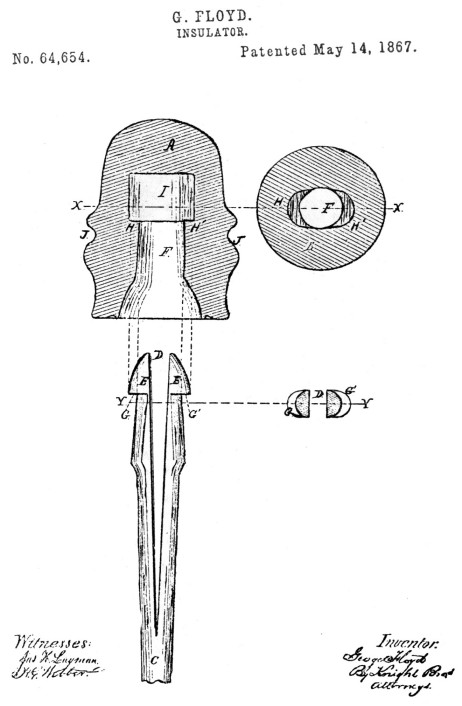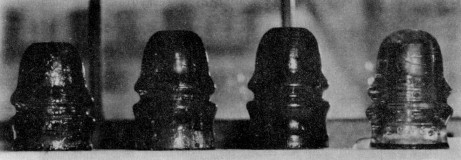"Threadless Corner" -- The Floyd Threadless
by Ray Klingensmith
Reprinted from "INSULATORS - Crown Jewels of the Wire", July 1978, page 18
On May 14, 1867, George Floyd, a resident of Cincinnati, Ohio, received a
patent for a very unusual threadless insulator. Although this particular item
could have been covered in "Patent Pages", I felt it might be of
special interest to those who study and collect threadless, so I'll cover it
here.
To my knowledge, none of this particular design have been found. The
"slotted" Oakman threadless are somewhat similar, and another special
pin type threadless was found a couple years ago, but both of those items are
different. I strongly feel the "Floyd" was produced because of the way
the patent is written. Floyd states the insulator is made of glass. Sometimes
an inventor indicates his particular insulator "could be made" of
different materials. When an inventor states "it is made" of glass, or
states one other particular insulating material, I believe he must have
already done some experimenting before applying for a patent, and more than
likely already produced some items. Below are the contents of the patent
application.
| To all whom it may concern:
Be it known that I, George Floyd, of
Cincinnati, in the county of Hamilton, and State of Ohio, have invented a new
and useful insulator; and I hereby de clare the following to be a full, clear,
and exact description thereof, reference being had to the accompanying
drawings, making part of this specification.
The object of this invention is a
construction of glass-insulating bulb and its shank, which enables the ready
renewal of the former when broken, or of its temporary removal and replacement
for any purpose.
A is an axial section, and B a horizontal section, at the line
XX of my glass insulator; D, a transverse section at the line YY of my shank,
which shank may be of brass, steel, or iron, and be parted, D, at the top, and
terminate in two similar tapering heads, EE', adapted for insertion up the axial
aperture F of the insulator proper and having shoulders GG', adapted to engage
over ledges HH', forming the bottom of the en larged termination or chamber I,
of said aperture. The chamber I and beveled head EE', being oblong in their
transverse section, effectually prevent any rotation of the bulb upon its shank,
and hold it firmly in po sition for the application of the telegraph wire, for
which the customary groove J is provided. The aper ture F flares or expands
outwardly for the double pur pose of facilitating the admission of the shank in
the act of insertion, and of permitting of the application of a vise or pair of
pincers to compress together the two heads EE' so as to enable the removal of a
cracked or otherwise imperfect insulator. |

Large Image (105 Kb)
George Floyd had a very good idea. Sometimes an inventor will have one good
idea pertaining to an insulator, but will fail to realize the effects and
difficulties of his invention in actual use. Floyd not only invented an
insulator which "locked" onto the pin, but he also took into
consideration the insulator could rotate on the pin. He therefore designed the
top of the pinhole with an oblong opening, which prevented rotation. He also
took into consideration the fact that the insulator could be damaged or broken
in use, and therefore designed the pinhole opening in a manner in which the pin
could be removed and another insulator put in use. His invention seems to be a
good one, and having advantages over the common "threadless" of the
time, I would feel his insulators would be accepted by telegraph line
contractors. The only disadvantages I can see would be a higher cost for these,
because a special pin would be needed.
Note the signature of the attorney on the patent copy is that of George
Knight. The name "Knight Bros., Attorneys" appears on many, many of
the patents from the southwestern part of Ohio. This includes the inventions by
Hemingray, which leads us to one possible manufacturer of the "Floyd
Threadless", if these were in fact produced. With all the possibilities
weighed, I wouldn't be a bit surprised if some day someone walked into a show
with a "funny lookin' Floyd threadless"! I can just see it now, a deep
emerald green CD 729 with the unusual pinhole. Grab your shovel and start diggin'!
Next month -- the "Wade".
If anyone has any information to add, please contact me at 709 Rt.
322, East Orwell , Ohio 44034. At the present time I have a little info in my
"insulator library" and have tried to purchase more books, catalogs,
etc., but information is scarce. If all the collectors want these articles to be
as informative as possible, then I'll need some help. Many have gone out of
their way to help out, and it is greatly appreciated. In the future I will need
as much information and photos as possible. If you send photos, try to have
sharp, clear, high contrast black and white shots, preferably close-ups. I have
many articles planned, and would like to correspond with anyone who has
information on, or has the following insulators (This includes catalogs,
advertising, photos, drawings, information as to where certain items were used,
anything): Mulford & Biddle, Lefferts, Tillotson, Oakman, Keeling, Greeley,
Boston Bottle Works, Chester, U.S. Tel., So. Ex. Co., Foster, Dupont. Thanks!
UPDATE ON THREADLESS
Since the article was written on the CD 735 UPRR in the April issue, I've
learned of more color variations. I have seen what I would call a "light
blue" variant. This isn't the usual aquamarine color found in these -- it
leans more toward a blue shade. Jack Hayes reports having a green one. So that
makes a total of four colors in that item. Dick Bowman sent the photo of the CD
732's. It arrived just after my deadline for sending the 732 article to the
editor, and with a lack of space in the June column, I saved it until this
month. Thanks to Jack and Dick for their help.

Photo of CD 732's courtesy of Dick Bowman
From the left: "Short" size unembossed, "medium" size
unembossed, root-beer amber mold line over dome variant, the embossed LGT &
Co.
|
